HON HAI PRECISION IND T60H786 802.11b/g MiniPCI module User Manual
HON HAI Precision Ind. Co., Ltd. 802.11b/g MiniPCI module
user manual
1
U S E R ’ S M A N U A L
T60H786
Mini-PCI Type IIIB 802.11b/g WLAN CARD
Ambit Microsystems Corporation
5F-1, 5 Hsin-An Rd., Hsinchu Science-Based Industrial Park, Hsinchu, Taiwan, R.O.C.
TEL: 886-3-5784975, FAX: 886-3-5782924, Internet: Ambit@shts.seed.net.tw
2
Contents
SECTION ONE: INTRODUCTION .................................................................................................1
1-1 F
EATURES
..........................................................................................................................1
1-2 R
EGULATORY
N
OTICE
...................................................................................................3
FCC C
LASS
B S
TATEMENT
...................................................................................................................3
C
ANADIAN
R
EGULATORY
W
IRELESS
N
OTICE
........................................................................................4
E
UROPEAN
U
NION
N
OTICE
....................................................................................................................4
SECTION TWO: WIRELESS LAN INSTALLATION AND UNINSTALLATION .....................5
2-1 S
YSTEM
R
EQUIREMENTS
................................................................................................................5
2-2 I
NSTALLATION
P
ROCESS
.................................................................................................................5
2-3 U
NINSTALLATION
P
ROCESS
..........................................................................................................10
SECTION THREE: WIRELESS UTILITY AND CONFIGURATION......................................13
3-1 W
INDOWS
98SE/NT4/2000/XP W
IRELESS
U
TILITY
.....................................................................13
3-2 C
URRENT
S
TATUS
T
AB
.................................................................................................................14
3-3 P
ROFILE
M
ANAGEMENT
................................................................................................................15
4-4 D
IAGNOSTIC
T
AB
..........................................................................................................................22
4-5
A
CTION
M
ENU
..............................................................................................................................23
SECTION FOUR: WINDOWS XP WIRELESS UTILITY AND CONFIGURATION................25
4-1 W
INDOWS
XP W
IRELESS
U
TILITY
................................................................................................25
APPENDIX A GLOSSARY ................................................................................................................32
The information contained in this manual has been verified at the time of this manual printing. The
manufacturer reserves the right to make any changes and improvements in the product described in this
manual at any time and without notice.
All registered trademarks are the property of their respective owners.
1
Section One: Introduction
IBM Wireless Mini-PCI Module complied with IEEE 802.11b/g Standard, it can be
used to provide a variety of low-cost wireless network interface card to connect your
wireless LAN via fitting into the Mini-PCI Type III slot. The Wireless Mini-PCI
Module that complies with this specification and combines networking with high-
speed Internet access will let people connect to the Internet anywhere, anytime.
With seamless roaming, fully interoperability and advanced security with WEP
standard, Wireless Mini-PCI Module can allow user to switch to different vendors’
Access Points through the wireless networks and to prevent from eavesdropping.
1-1 Features
1-1-1 Wireless LAN Function
802.11g
Radio Technology IEEE 802.11g
draft standard compliant
Operating Frequency 2400 ~ 2497MHz ISM band
Spreading IEEE 802.11b DSSS (Direct Sequence Spread
Spectrum)
IEEE 802.11g OFDM (Orthogonal Frequency Division
Multiplexing)
Channel Numbers 11 channels for United States
13 channels for Europe Countries
14 channels for Japan
Data Rate 802.11g : 54Mbps with fall back rates of 48, 36, 24, 18,
12, 9 and 6Mbps
802.11b : 11Mbps with fall back rates of 5.5, 2, and
1Mbps
Modulation Schemes 802.11g: 64QAM(54Mbps, 48Mbps),
16QAM(36Mbps, 24Mbps), QPSK (18Mbps, 12Mbps),
BPSK (9Mbps, 6Mbps)
802.11b: CCK (11 Mbps, 5.5Mbps), DQPSK (2 Mbps),
DBPSK (1 Mbps)
2
Media Access Protocol CSMA/CA with ACK
Transmitter Output Power Typical 12 dBm for 54Mbps
Typical 13 dBm for 48Mbps
Typical 14 dBm for 36Mbps
Typical 15 dBm for 24, 18, 12, 9, 6Mbps
Typical 17 dBm for 11, 5.5, 2, 1Mbps
Receiver Sensitivity Typical –70 dBm for 54Mbps @ 10% PER
Typical –72 dBm for 48Mbps @ 10% PER
Typical –78 dBm for 36Mbps @ 10% PER
Typical –81 dBm for 24Mbps @ 10% PER
Typical –81 dBm for 18Mbps @ 10% PER
Typical –81 dBm for 12Mbps @ 10% PER
Typical –81 dBm for 9Mbps @ 10% PER
Typical –81 dBm for 6Mbps @ 10% PER
Typical –83dBm for 11Mbps @ 8% PER
Typical –85dBm for 5.5Mbps @ 8% PER
Typical –86dBm for 2Mbps @ 8% PER
Typical –90dBm for 1Mbps @ 8% PER
Current Consumption 630mA at transmit mode (typically)
330mA at receive mode (typically)
Federal Communication Commission Interference Statement
This equipment has been tested and found to comply with the limits for a Class B digital device,
pursuant to Part 15 of the FCC Rules. These limits are designed to provide reasonable
protection against harmful interference in a residential installation. This equipment generates,
uses and can radiate radio frequency energy and, if not installed and used in accordance with
the instructions, may cause harmful interference to radio communications. However, there is no
guarantee that interference will not occur in a particular installation. If this equipment does cause
harmful interference to radio or television reception, which can be determined by turning the
equipment off and on, the user is encouraged to try to correct the interference by one of the
following measures:
- Reorient or relocate the receiving antenna.
- Increase the separation between the equipment and receiver.
- Connect the equipment into an outlet on a circuit different from that to which the receiver is
connected.
- Consult the dealer or an experienced radio/TV technician for help.
FCC Caution: To assure continued compliance, any changes or modifications not expressly
approved by the party responsible for compliance could void the user's authority to operate this
equipment.
This device complies with Part 15 of the FCC Rules. Operation is subject to the following two
conditions: (1) This device may not cause harmful interference, and (2) this device must accept
any interference received, including interference that may cause undesired operation.
Statement Needed to be Shown on End Product
Since this module is installed inside the end product, the end product should be affixed a label on
visible area showing that this product contain a RF module, and also its FCC ID.
IMPORTANT NOTE:
FCC Radiation Exposure Statement:
This equipment complies with FCC radiation exposure limits set forth for an uncontrolled
environment. This equipment should be installed and operated with minimum distance 20cm
between the radiator & your body.
This transmitter must not be co-located or operating in conjunction with any other antenna or
transmitter.
The OEM integrator has to be aware not to provide information to the end user regarding how to
install or remove this RF module in the users manual of the end product which integrate this
module.

This device is intended only for OEM integrators under the following conditions:
1) The antenna must be installed such that 20 cm is maintained between the antenna and users, and
2) The transmitter module may not be co-located with any other transmitter or antenna.
As long as the 2 conditions above are met, further transmitter testing will not be required. However,
the OEM integrator is still responsible for testing their end-product for any additional compliance
requirements required with this module installed (for example, digital device emissions, PC peripheral
requirements, etc.).
IMPORTANT NOTE: In the event that these conditions can not be met (for example certain laptop
configurations or co-location with another transmitter), then the FCC authorization is no longer
considered valid and the FCC ID can not be used on the final product. In these circumstances, the
OEM integrator will be responsible for re-evaluating the end product (including the transmitter) and
Obtaining a separate FCC authorization.
End Product Labelling
This transmitter module is authorized only for use in devices where the antenna may be installed such
that 20 cm may be maintained between the antenna and users ( for example: Notebook ).
The final end product must be labeled in a visible area with the following: “ Contains TX FCC ID:
MCLT60H786 ”.
Manual Information That Must be Included
The users manual for end users must include the following information in a prominent location “
IMPORTANT NOTE: To comply with FCC RF exposure compliance requirements, the antenna used for
this transmitter must be installed to provide a separation distance of at least 20 cm from all persons and
must not be co-located or operating in conjunction with any other antenna or transmitter.”
4
Canadian Regulatory Wireless Notice
Operation is subject to the following two conditions: (1) this device may not cause interference, and (2)
this device must accept any interference, including interference that may cause undesired operation of
the device.
European Union Notice
Products bearing the CE marking comply with the R&TTE Directive (1999/5/EC), EMC Directive
(89/336/EEC) and the Low Voltage Directive (73/23/EEC) issued by the Commission of the European
Community.
AMBIT declares that T60H786 ( FCC ID: MCLT60H786 ) is limited in CH1~CH11 by
specified firmware controlled in U.S.A.
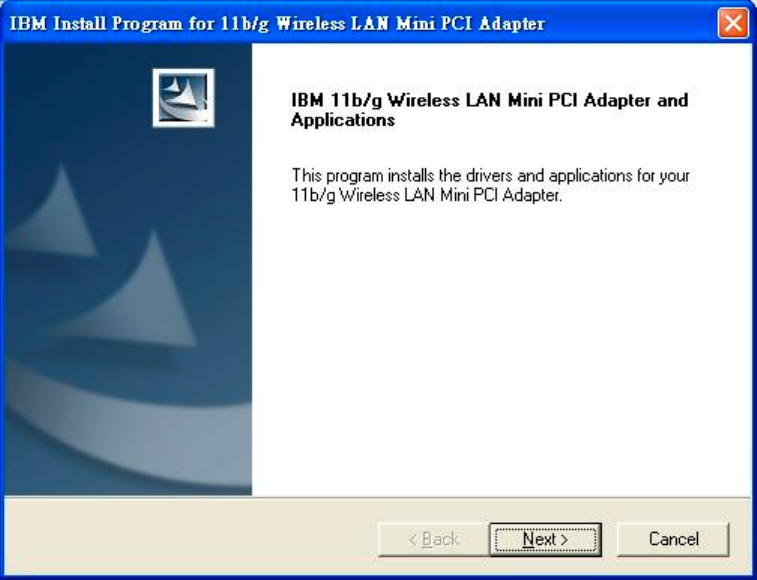
5
Section Two: Wireless Lan Installation and Uninstallation
2-1 System Requirements
In order to install Wireless LAN driver and Utility and use the Wireless LAN card in your notebook computer.
Your notebook system must meet the following requirements:
!
IBM Mini-PCI Wireless LAN Card already inserted
!
Windows 98SE, NT4, 2K, XP OS Support
2-2 Installation Process
1.
you can execute the program ‘Setup.exe’ in the CD. Windows displays the dialog as
below. Press ‘Next’ button to continue.
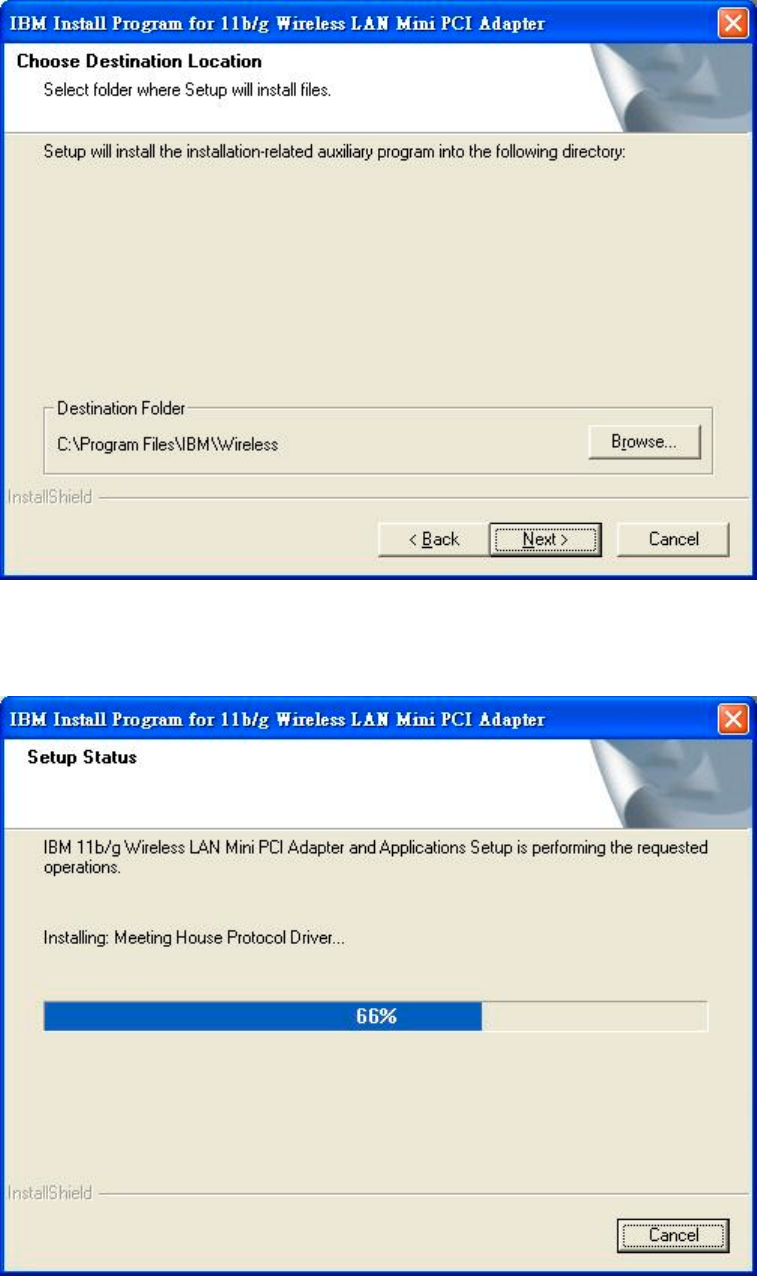
6
2.
Select the destination folder that you want to place the files.
3.
Wait for the install program to do the installation.
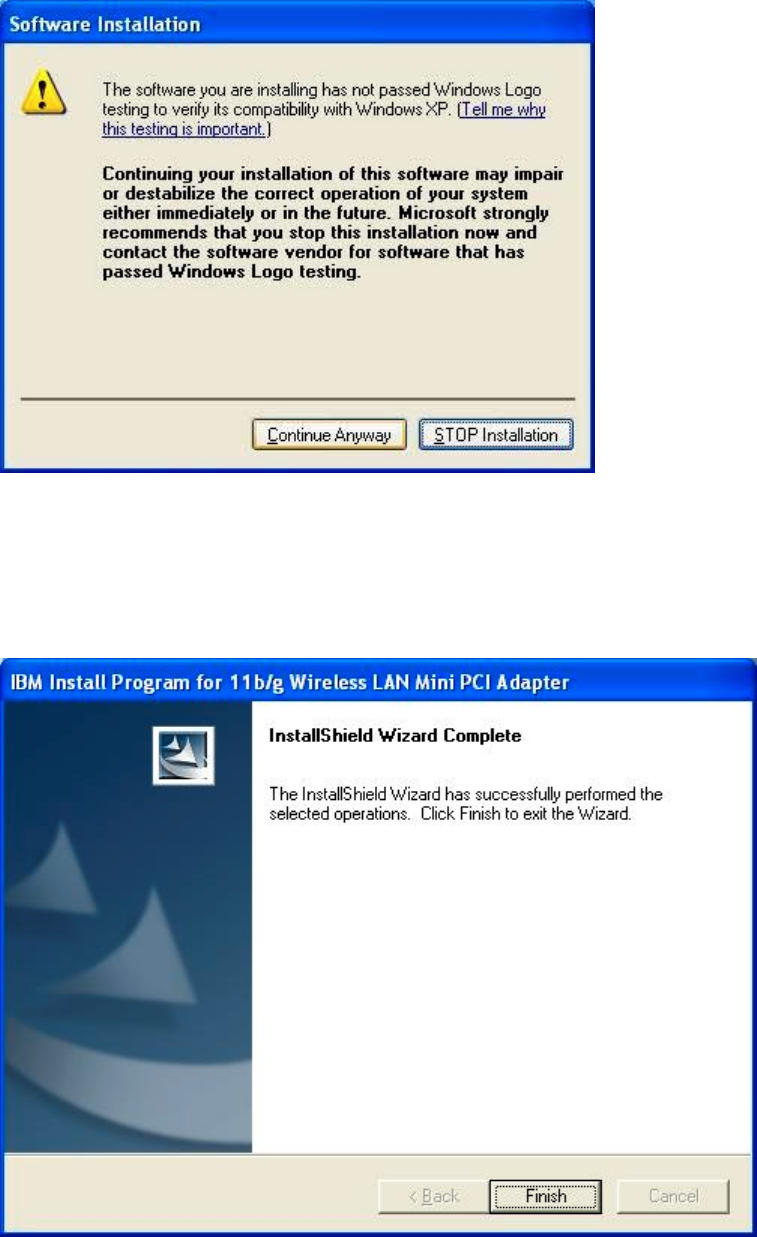
7
Window displays the cautions screen automatically.
Press ‘Continue Anyway’
button to continue. After obtainning the WHQL certification, this caution screen will
not appear.
4.
Congratulations! Wireless LAN has been installed successfully.
Please click ‘Finish’ to complete setup and go to the next step.
Please remove any
disks from any drives before your click ‘Finish’.
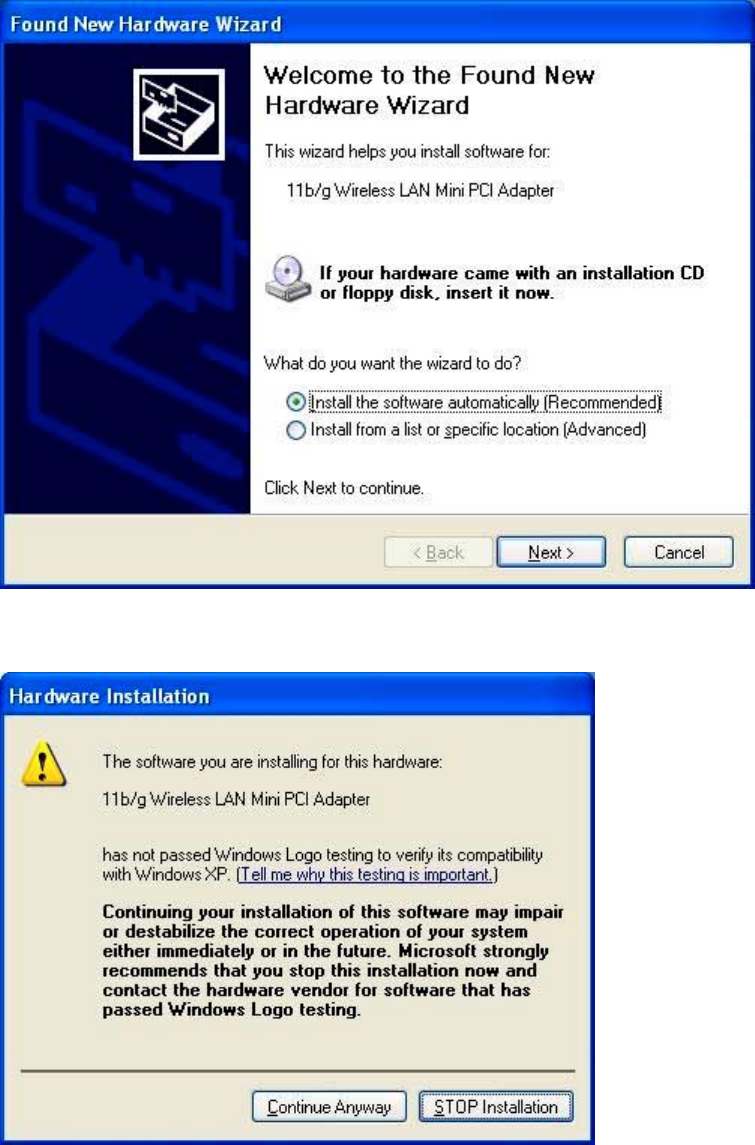
8
5. Dut to we haven’t obtained WHQL certification yet, following three displays will
appear after installation completion.
After obtainning the WHQL certification, this
caution screen will not appear.
Press ‘Next’ button to continue.
Press ‘continue Anyway’ button to continue.
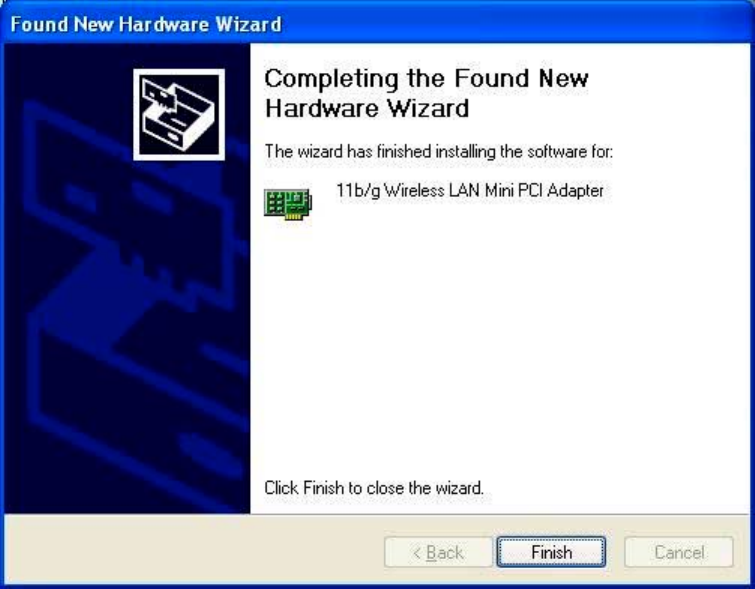
9
Please click ‘Finish’ to complete setup and go to the next step.
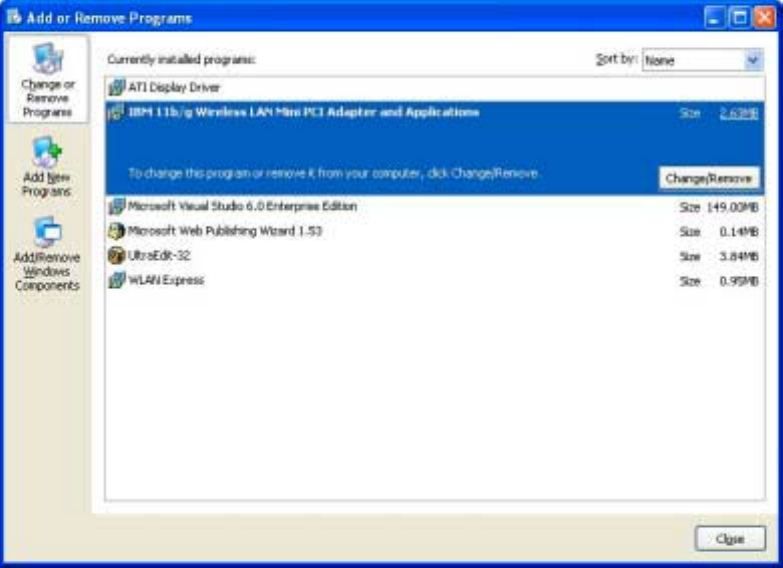
10
2-3 Uninstallation Process
1. One can remove the Wireless LAN via the ‘Add or Remove Programs’ in the
‘Control Panel’. Click ‘Change or Remove Programs’ button and select
‘Wireless LAN’, the dialog as below displays. Then click ‘Change/Remove’
button to perform the un-installation.
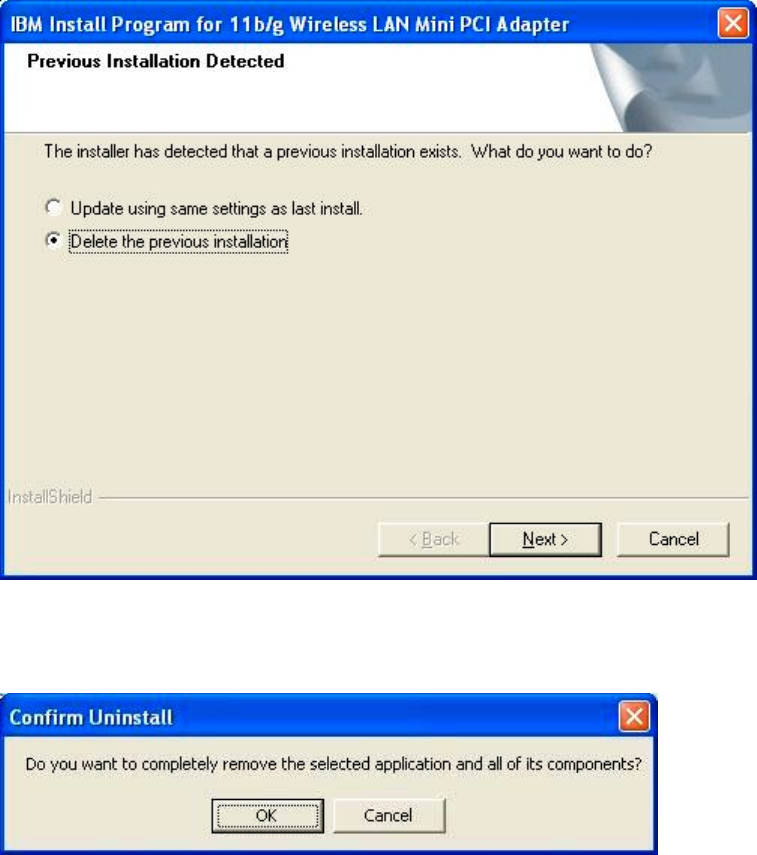
11
2. Select ‘Delete the previous installatoin’ and then click the ‘Next’ button to go
to the next step.
3. Click ‘OK’ button if you really want to remove the Wireless LAN.
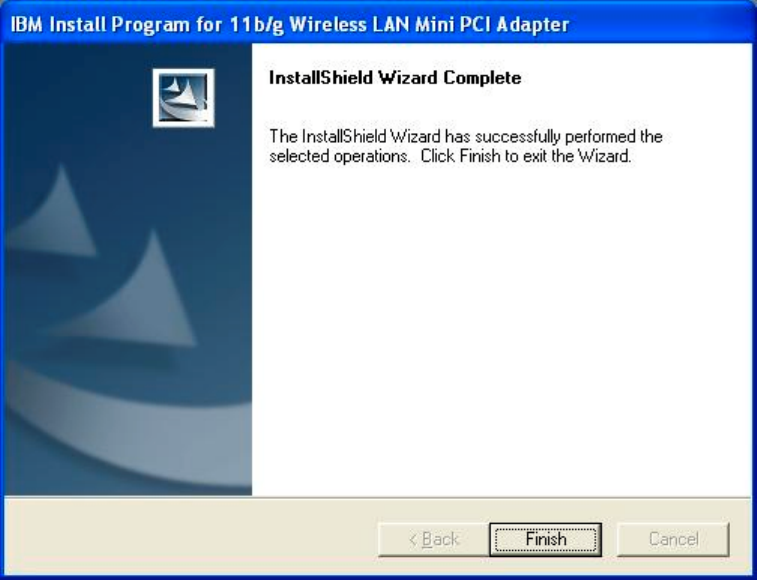
12
4. Click ‘Finish’ to complete the un-Installation.
13
Section Three: Wireless Utility and Configuration
The following sections describe the Wireless Network Configuration Utility. This
utility provides quick access and friendly interface to configure the card setup.
3-1 Windows 98SE/NT4/2000/XP Wireless Utility
After installation is completed, a Wireless LAN Utility icon will appear in the system
tray each time your computer is restarted. Click it, then you will see the display of
Wireless Client Utility. If you cannot find the icon, you can select ‘
Start\Programs\IBM
Wireless\Wireless Client Utility’.
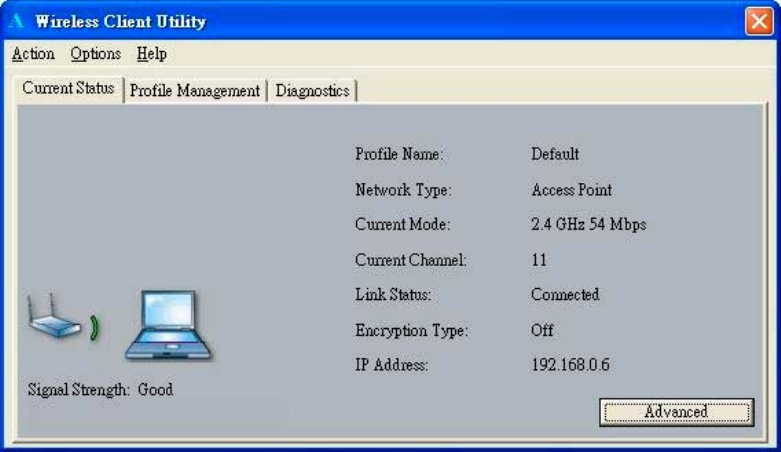
14
3-2 Current Status Tab
The current status tab displays the following information about your wireless
connection.
!
Profile Name –
The current name of the selected configuration profile.
!
Network Type – The current type of wireless network that is either Access Point
or Ad-hoc.
!
Current Mode – The current mode is the frequency and data rate that has been
selected.
!
Current Channel – Specifies the current channel that the WLAN 802.11b/g is
connected to or scanning on.
!
Link Status – The link can be either connected or disconnected to an Access
point or other wireless client.
!
Encryption Type – Describes whether or not the wireless traffic is encrypting.
!
IP Address –The current IP address of the WLAN 802.11b/g
Figure 3-1
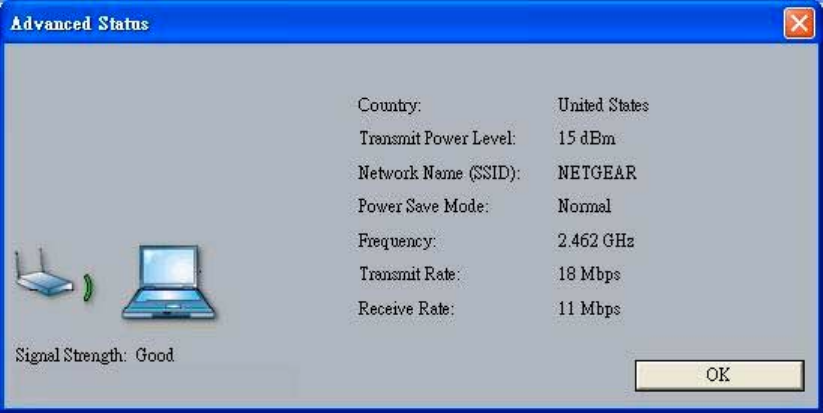
15
The Advanced button provides more detailed information regarding your wireless
connection.
!
Country – The country the card is set for.
!
Transmit Power Level – Provides current setting of Radio output power.
!
Network Name (SSID) – The wireless network name (SSID) that the device is
currently connected with.
!
Power Save Mode – The type of Power Savings that is configured on the device.
!
Frequency – The current frequency that the Wireless device is connected or
scanning on.
!
Transmit Rate – The transmit rate (Mbps) for the current connection for the
wireless driver.
!
Receive Rate –The receive rate (Mbps) for the current connection for the driver.
Figure 3-2
3-3 Profile Management
The Profile Management tab allows the user to configure several different user
defined profiles. Each profile can be configured to match the appropriate settings of a
unique wireless network.
The Profile box lists all the configured profiles. The Details dialog describes the basic
settings (SSID, Network Type, Security Mode) of the highlighted profile. The active
profile will be displayed with the wireless icon next to it. To make a profile active,
highlight the profile and click on the Activate button. By setting a Profile active, you
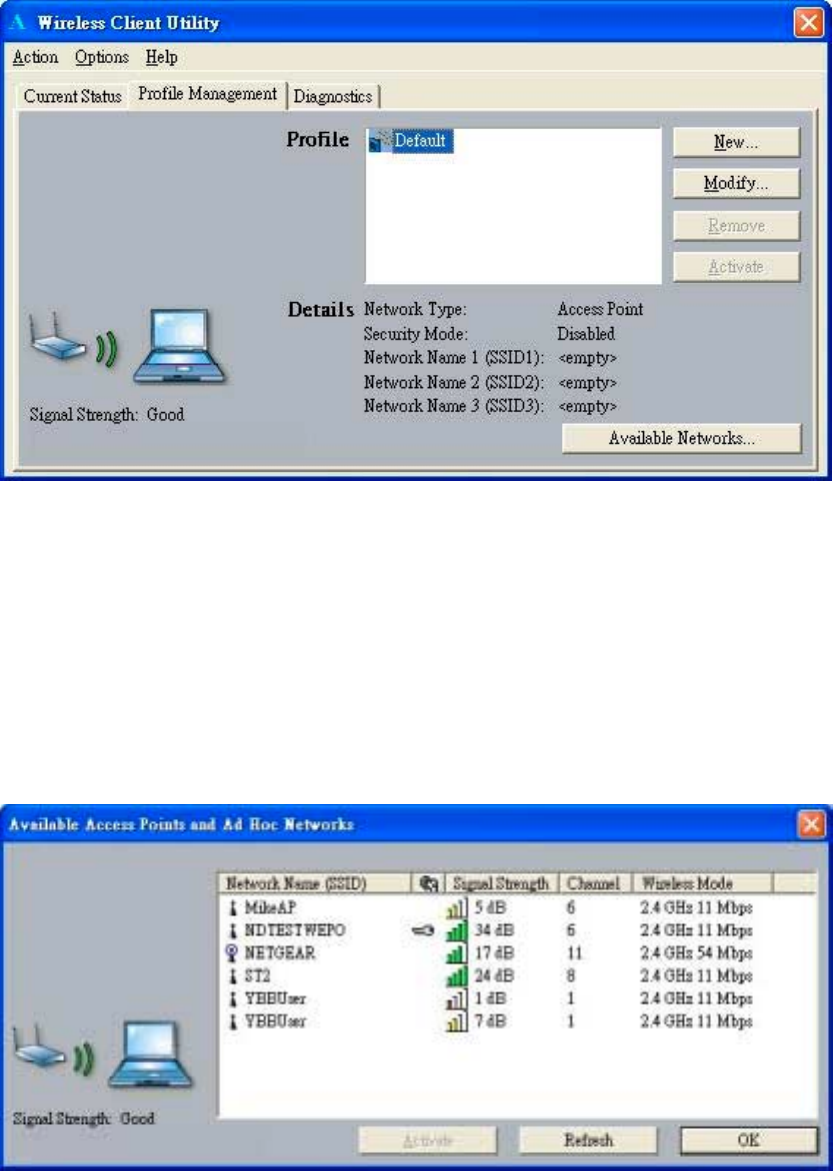
16
configure the wireless device to search for wireless networks that match up to those
specific profile wireless settings.
Figure 3-3
The Available networks button allows the user to view a list of all available wireless
network that are within range of the WLAN 802.11b/g . Each wireless network entry
displays the SSID, encryption settings, signal strength level, channel and wireless
mode information. You can create a new profile utilizing Available networks button
by highlighting the wireless network you want to create a profile for and clicking on
the Activate button.
Figure 3-4
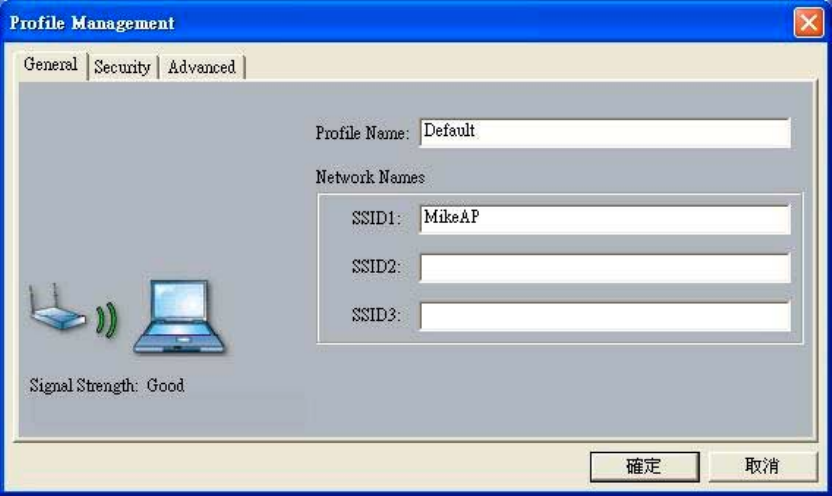
17
3-3-1 Create or Modify a Profile
1. From the Profile Management tab Click on the New or Modify button
2. The Network Configuration Settings dialog box will appear
3. In the Profile Name box, type in a unique name that describes the wireless
network you are configuring the settings to connect to.
4. In the SSID boxes type in the SSID that matches up with the wireless network
you are trying to configure the profile to connect with. There are three SSID
selections (SSID1, SSID2, SSID3) available; this feature allows you to
configure a single profile to match up to 3 different SSID’s.
Figure 3-5
5. Select the Security Tab to manage the security settings associated with this
profile
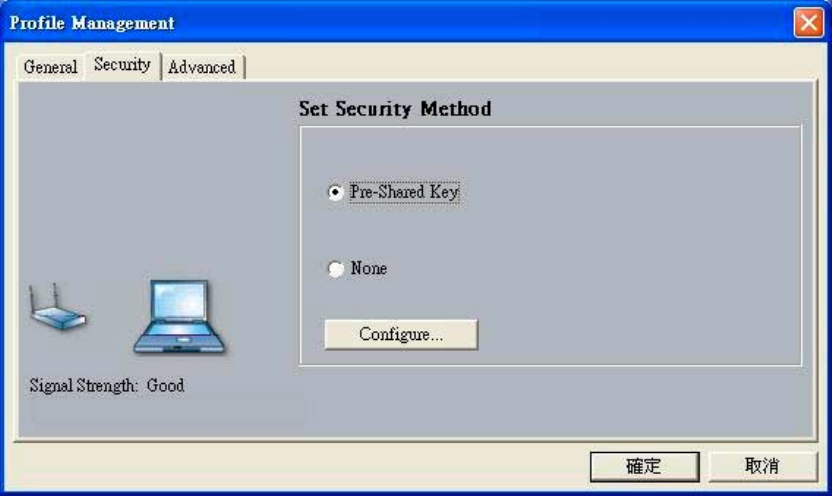
18
Figure 3-6
6. Choose the security setting that is required on the wireless network. Once the
appropriate security mode is chosen the button next to the selection will enable
you to include any additional information required by that security mode.
3-3-2 Security Settings in Profile Management
The Security Tab allows you to configure the WLAN 802.11b/g device to match the
security settings of the Wireless LAN network.
Select the appropriate security mode
• Pre-Shared Keys – This mode is commonly referred to as WEP encryption, and
allows for setting of all four WEP keys. The pre-shared key selection also
allows for setting of a unique key, which is used with higher forms of encryption
such as AES.
• None – Use this mode when there is no security authentication or encryption is
currently enabled on your Wireless LAN network.
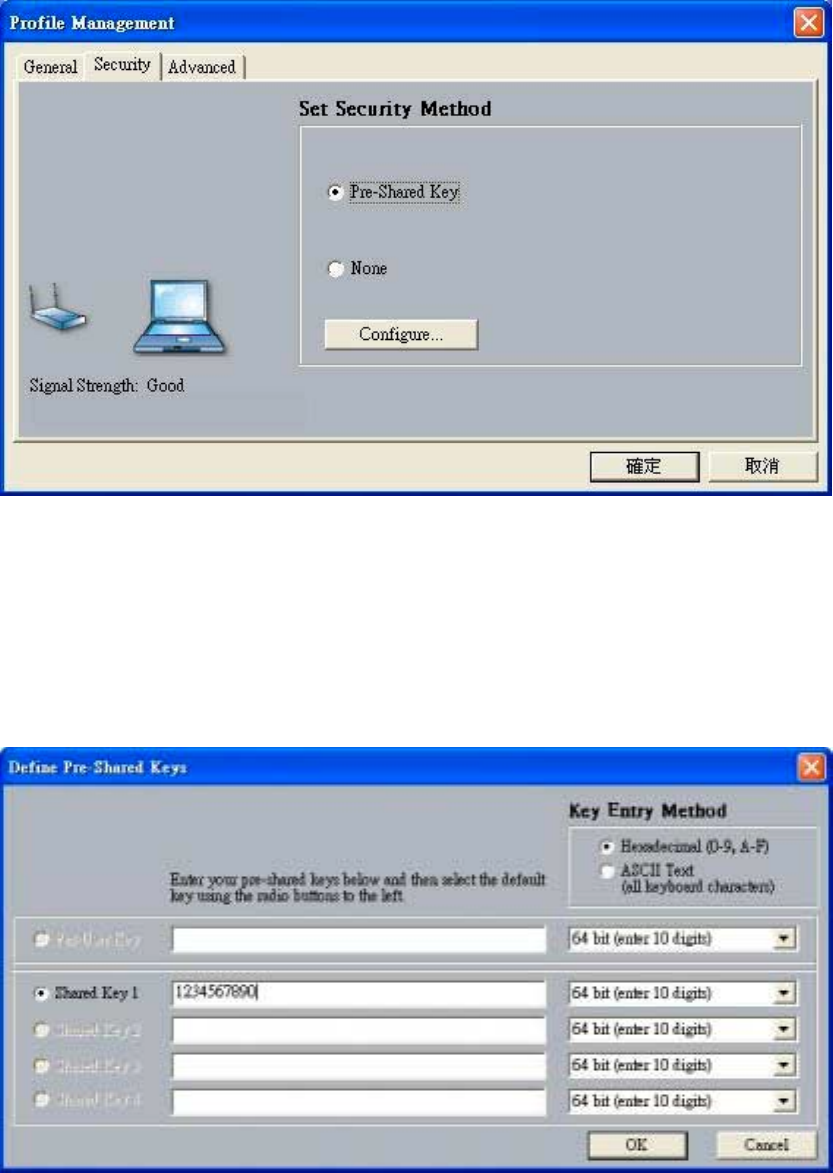
19
Figure 3-7
Setting Pre-Shared Keys
Pre-Shared keys can be defined using the “Define Pre-Shared Keys” box
Figure 3-8
Key Entry Method – Determines the entry method for an encryption key:
• Hexadecimal (0-9, A-F)
• ASCII text (any keyboard characters, A-Z, 0-9).
20
Pre User Key – Defines the unique encryption key for network configuration security.
The Pre User key is used with many authentication mechanism and encryption
Shared Keys – Determines a set of shared encryption keys (First, Second, Third, Fourth)
used for wireless encryption and security. At least one Shared Key field must be
populated to enable security using a shared key. If more then one key is defined then
Click on the radio button to select a key as the default encryption key.
Key Length – The options for Key Length are
• 64 bit encryption (10 digits)
• 128 bit encryption (26 digits)
• 152 bit encryption (32 digits)
The number of available characters allowed to be entered in the encryption key field will
automatically be determined by the Key length setting.
None
Select this mode when there is no authentication or encryption enabled on the
wireless LAN network.
3-3-3 Advanced settings in Profile Management
The advanced tab provide more complex wireless settings and these settings should only
be modified if there is a specific requirement on your wireless network.
a. Power Save Mode - allows the user to minimize power utilized by the
WLAN 802.11b/g device. Note: Setting Power Save Mode to enabled
(Normal or Maximum) may cause the user to experience an extended
connection delay of up to one minute.
b. Network Type - allows the user to configure the WLAN 802.11b/g device
as either an Ad-hoc or Access point type network
c. 802.11b Preamble - allows setting the preamble support to match up with
the specified wireless network.
d. Transmit Power Level - allows the user to modify the power output of the
radio. Setting. Note: Setting this to any other value except 100% will
decrease range of your WLAN 802.11b/g device.
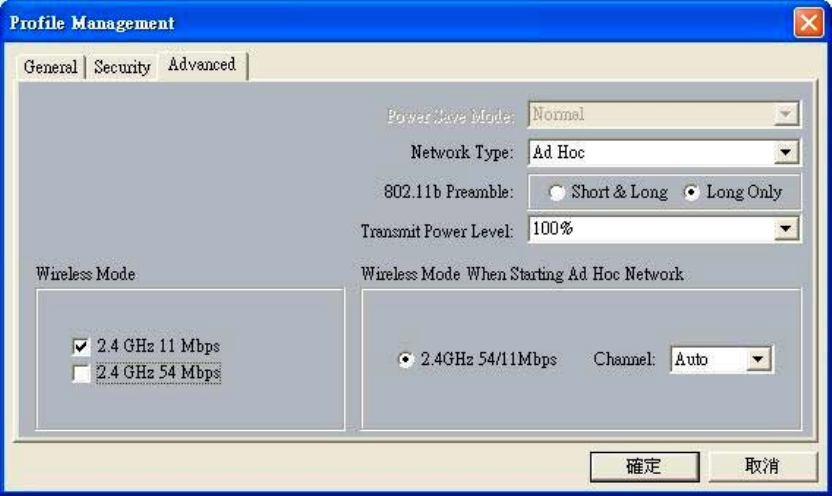
21
Figure 3-9
Wireless Mode Setting
The wireless Mode settings allow the user to specify which wireless frequency and data
rate the wireless network is operating at. If all selections are chosen, the WLAN
802.11b/g device will automatically search all frequencies and data rates for wireless
networks that match up to the profile settings.
Wireless Mode when starting Ad-Hoc setting
The “Wireless Mode when starting ad-hoc setting” allows the user to determine the type
of ad-hoc network to be started. Note: This setting will only take effect if there are no
other ad-hoc networks with the same SSID currently operating within range. If existing
ad-hoc networks with the same SSID are currently operating, then the WLAN 802.11b/g
device will connect using the frequency and data rate provided by the exiting ad-hoc
network.
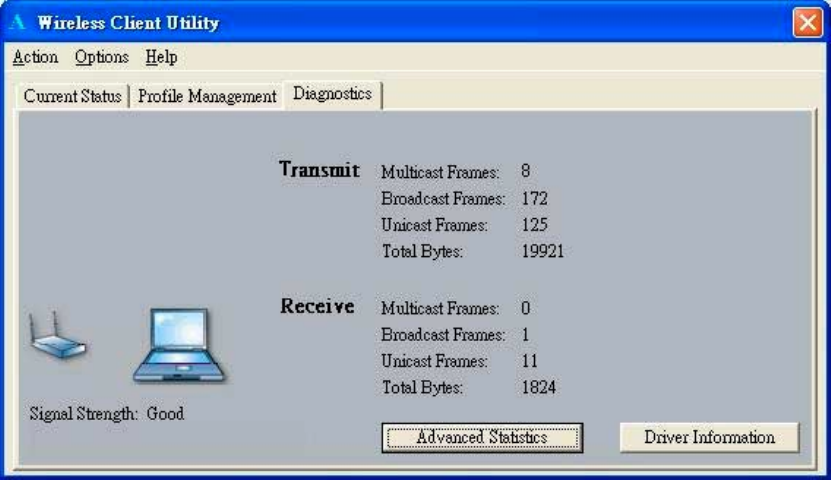
22
4-4 Diagnostic Tab
The diagnostic TAB displays the current data statistics for both receive and transmit.
Additional statistics and driver information can be displayed using the appropriate
labeled buttons.
Figure 3-10
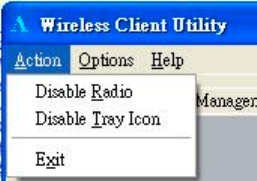
23
4-5 Action Menu
The Action menu allows for enabling and disabling both the wireless radio and/or system
tray icon.
Figure 3-11
4-5-1 Enable/Disable Radio
There may be situations when the user wants to disable the WLAN 802.11b/g device’s
radio, so that the wireless device cannot send or receive any wireless traffic. If a user is in
an environment where there are no wireless networks, the user may turn off the radio in
order to minimize power consumption of the WLAN 802.11b/g device.
In the ACTION menu of the Wireless Client Utility there is an Enable Radio/Disable
Radio selection. The choice provided in the menu will toggle the current state of the radio.
•
Enable Radio: The Radio is currently OFF (Disabled), and the “Enable Radio”
selection will turn ON the Radio of the wireless device.
•
Disable Radio:
The Radio is currently ON (Enabled), and the “Disable Radio”
selection will turn OFF the Radio of the wireless device
The WLAN 802.11b/g device radio also may be disabled through an external button located
on your platform, please review your platform user’s guide for additional information about
the wireless enable/disable button
4-5-2 Enable/Disable Tray Icon
In the ACTION menu of the Wireless Client Utility there is an Enable Tray Icon/Disable
tray Icon selection. The choice provided in the menu will toggle the current state of the
System tray Icon.
•
Disable Tray Icon: This will remove the tray icon from you system tray. The
system tray icon appears in the system tray again after system is restarted or if
the Wireless Client utility is opened again through Start\Programs\IBM
24
Wireless\Wireless Client Utility.
•
Enable Tray Icon:
This will allow for the system tray icon to once again be
placed in the system tray.
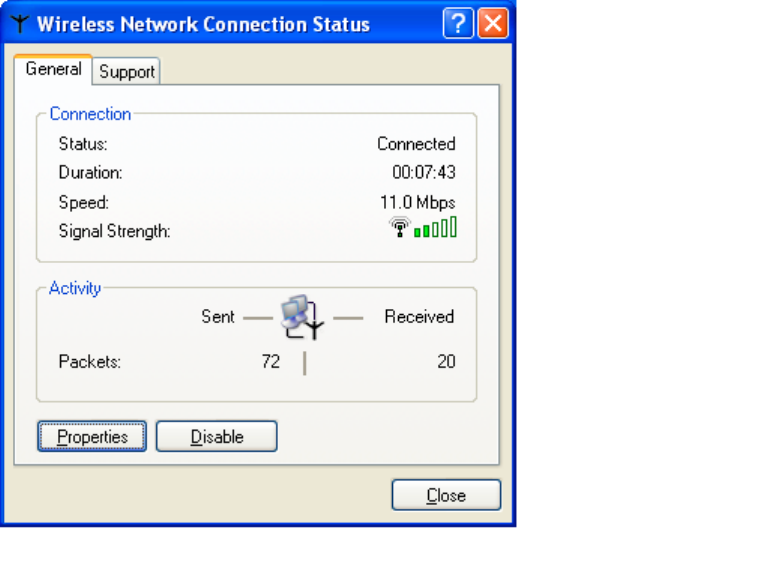
25
Section Four: Windows XP Wireless Utility and Configuration
4-1 Windows XP Wireless Utility
1. To configure the wireless card setting, you can select Start\Settings\Network Connection in
the Windows XP. Choose the wireless network connection, then you will see below screen.
From this screen, you can see wireless connection status and wireless signal level.
2. Select ‘Properties’ in the above screen. The following windows will show up.
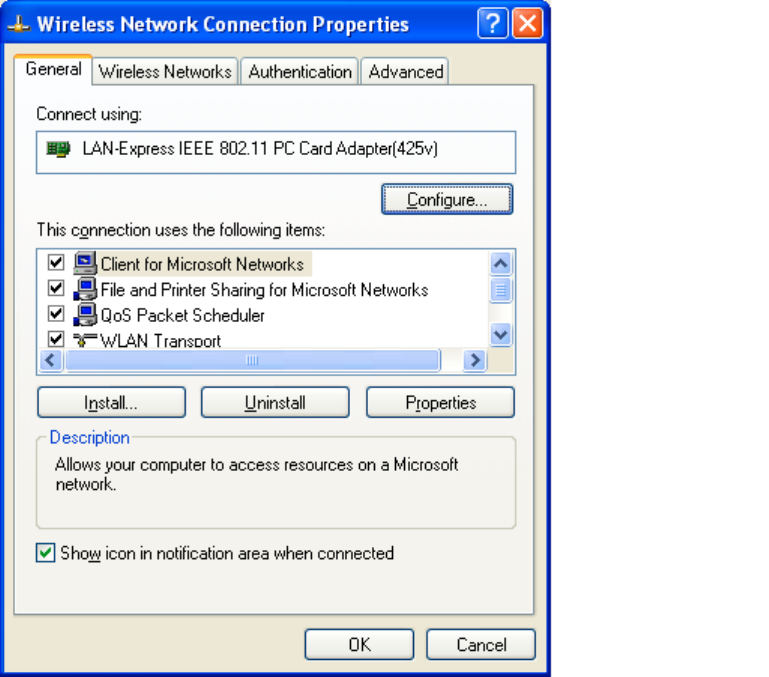
26
In ‘General’ page, Wireless LAN card information and networking protocol have been
displayed. Extra networking protocol can be installed in this page.
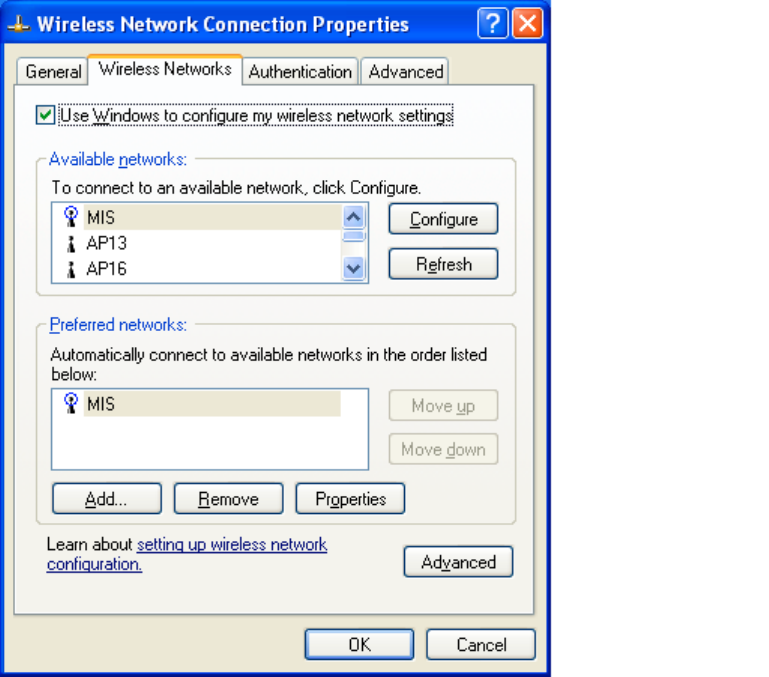
27
3. Select Wireless Networks page, you can see available wireless networks in your
nearby area. You can add your preferred wireless Access Point to your list, so your
wireless card will search for specific wireless networks.
Configure
To connect to an existing access point (infrastructure) network, under Available
networks, click the network name, and then click ‘Configure’ to setup wireless
security and data encryption.
Refresh
To update the list of available networks that are within range of your computer, click
Refresh.
Add
To connect to an access point (infrastructure) network that you know is available but
that does not appear under Available networks, under Preferred networks, click Add.
In Wireless Network Properties, specify the network name (Service Set Identifier).
Remove
To remove a wireless network from the list of preferred networks.
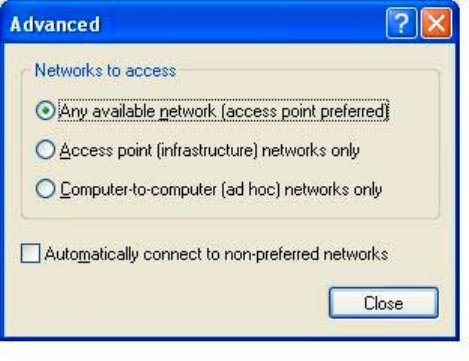
28
Advanced
*If your network are configuring to a computer-to-computer (ad hoc) network, select
‘Computer-to-computer (ad hoc) network only’.
*If you want to connect to a computer-to-computer and access point (infrastructure)
networks are within range of your computer, click ‘Access point
(infrastructure)network only’.
*If you want to connect to a computer-to-computer (ad hoc) network and both
computer-to-computer and access point (infrastructure) networks are within range of
your computer, click ‘Any available network (access point preferred)’.
To automatically connect to available networks that do not appear in the Preferred
networks list, click Advanced, and then select the Automatically connect to non-
preferred networks check box.
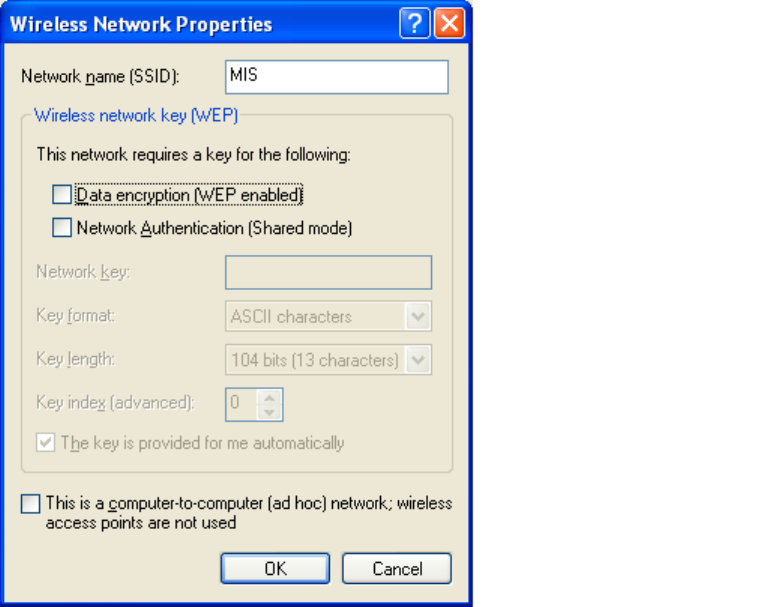
29
Define your network name (SSID) in the following windows, so your can join a
specific wireless network. Check AP has WEP on or not. You wireless network will
need to have same WEP setting with AP in order to communicate. If your wireless
network don’t have any AP, check the ‘This is computer-to computer (ad-hoc)
network; wireless access points are not used’
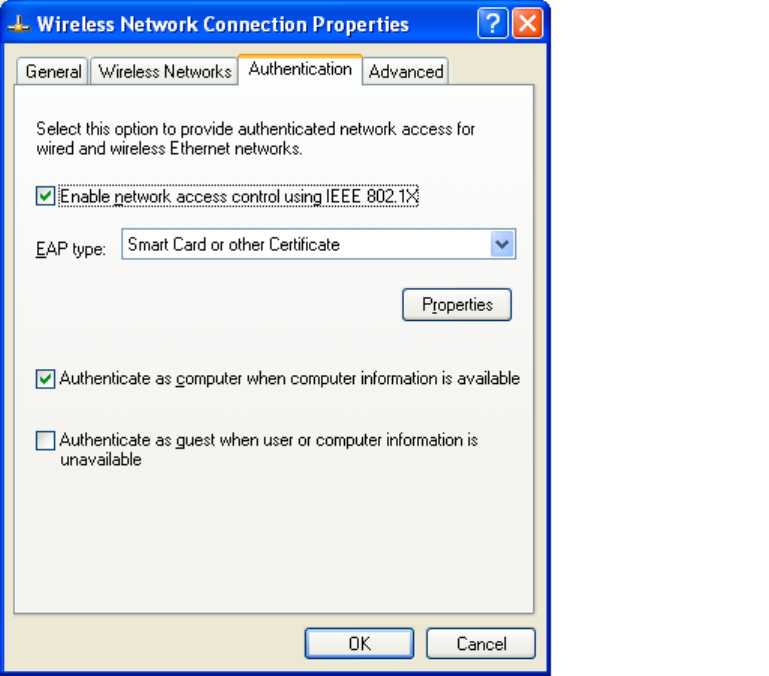
30
This window provides authentication via 802.1X. 802.1X, an IEEE standard that
provides an authentication framework for 802-based LANs. 802.1X takes advantage
of an existing authentication protocol known as the Extensible Authentication
Protocol. 802.1x, giving someone secure, encrypted, wireless access on a Microsoft
network will be as easy as setting a flag on the users domain account.
What does this mean for the Home Network user?
802.1x will ensure that if and when you make the change over to Wireless Ethernet, your
neighbor will not be able to access your wireless LAN!
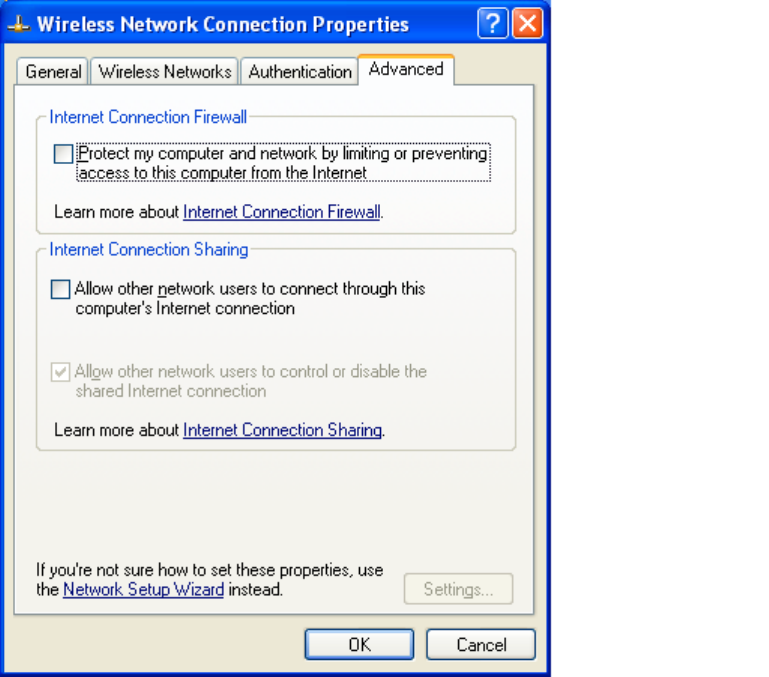
31
The ‘Advanced’ window offers Firewall and Internet Connection Sharing functions.
Depends on your networking environment, you can select below functions.
32
Appendix A Glossary
Access Point - An internetworking device that seamlessly connects wired and wireless
networks together.
Ad-Hoc - Ad-Hoc is a peer- to-peer wireless network without Access Point. A group
of wireless clients consistent an independent wireless LAN.
Backbone - The core infrastructure of a network, the portion of the network that
transports information from one central location to another central location. The
information is then off-loaded onto a local system.
BSS - Stands for “Basic Service Set.” An Access Point associated with several
wireless stations.
ESS - Stands for “Extended Service Set.” More than one BSS can be configured as an
Extended Service Set. An ESS is basically a roaming domain.
Infrastructure - An integrated wireless and wired LAN is called an Infrastructure
configuration.
MINI-PCI TYPE III– Mini-PCI is a small form factor version of the PCI
specification. The Mini-PCI format comes in several different form factors: the Type
I, Type II, and Type III. The Mini-PCI Type III card is the most popular of the Mini-
PCI standards. The Mini-PCI Type III golden finger plugs into a 124-pin card edge
type connector that is similar to the SODIMMS type. Mini-PCI provides the same
32bit 33MHz performance that you have come to expect from the PCI bus. Mini-PCI
is still pretty much an OEM product, as you are not yet able to go to a store and
purchase a Mini-PCI card.
Roaming - A function that allows one to travel with a mobile end system (wireless
LAN mobile station, for example) through the territory of a domain (an ESS, for
example) while continuously connecting to the infrastructure.
Wired Equivalent Privacy (WEP) - To prevent access from the unauthorized
wireless stations to the data that is transmitting through the network, the Wireless
LAN card provides the WEP (Wired Equivalent Privacy) level of security that was
part of the original 802.11 standard. The wireless LAN card supports both 64 bits
WEP and 128 bits data encryption based on the RC4 algorithm.
SSID - Short for Service Set Identifier. The SSID differentiates one WLAN from
another, so all access points and all devices attempting to connect to a specific WLAN
must use the same SSID. A device will not be permitted to join the BSS unless it can
provide the unique SSID.